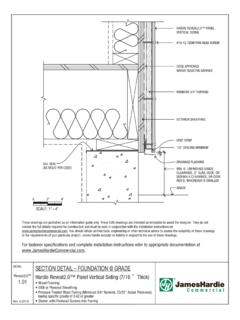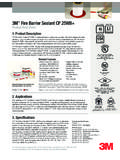Transcription of WINDOW WALL AND CURTAIN WALL: AN OBJECTIVE REVIEW
1 CON125-1 Leadership in Sustainable Infrastructure Leadership en Infrastructures Durables Vancouver, Canada May 31 June 3, 2017/ Mai 31 Juin 3, 2017 WINDOW WALL AND CURTAIN WALL: AN OBJECTIVE REVIEW * Marquis, Patrick1,3, Mirahadi, Farid1, Ali, Hiba1, McCabe, Brenda1, Shahi, Arash1, De Berardis, Paul2 and Lyall, Richard2 1 Building Tall Research Centre, Department of Civil Engineering, University of Toronto, Canada 2 Residential Construction Council of Ontario, Canada 3 Abstract: The enclosure designs for modern tall buildings in Canada often incorporate highly glazed cladding systems such as the WINDOW wall and the CURTAIN wall.
2 Simply put, the main difference between the systems is that the WINDOW wall structurally sits between the suspended reinforced concrete slabs while the CURTAIN wall is hung off the slab edges by anchors. However, there are many more intricacies that differentiate the systems. The aesthetically slick and more expensive CURTAIN wall is most often used in commercial buildings, while the highly customizable and constructible WINDOW wall is mostly used in residential construction. Further, CURTAIN walls are designed to be self-supporting structures and must be installed from the outside via crane or rig while WINDOW walls are supported by the existing structure and can be installed from inside.
3 In this paper, a comprehensive comparison of the two systems is presented. Thermal performance, water penetration, air leakage and moisture control are used as the metrics for each system s overall performance. A comparison is also made for the two systems constructability, cost, and maintainability. Recommendations are outlined for the best use of each system, and improvements to their standard builds are defined. Overall, the WINDOW wall and CURTAIN wall are very similar systems that can both be improved significantly from their typical designs. Both systems have their strengths, and can prove to be useful alternatives to each other with careful design.
4 1 Introduction Over the last 150 years, many important innovations have led the evolution of tall buildings. Technological advances such as elevators, tower and kangaroo cranes, air conditioning, and design methods for earthquake and wind forces have allowed buildings to reach taller and taller (Massarella, 2008). Most important, however, was the change in materials so that the building envelope no longer served as one of the main structural elements of the building. Moving away from stone and bricks as structural elements, the introduction of steel and concrete enabled buildings to reach higher and allowed them to have non-structural fa ades.
5 Prominent early adaptors of this method like the Fuller Flat Iron building (1902) and the Empire State Building (1931) in New York were able to build tall with steel frames and stone fa ades. Tall buildings were reserved for commercial use at the time, but high-rise residential buildings soon followed. Early iterations of the fa ades used stone and brick, and later cast in place concrete and pre-cast concrete panels were used. Glass fa ades were famously introduced on a large scale with The Crystal Palace (1851) in London for the Great Exhibition, however, it is argued that the modern glass fa ade as we know it, also known as the glass and metal CURTAIN wall, first appeared with the Hallidie Building in San Francisco in 1918 (Yeomans, 2001).
6 As the technology developed, and WINDOW glass became a more accessible material, the CURTAIN wall grew to be a favourite of modern architects and wealthy companies who wanted to design and construct state of the art buildings. While the aesthetic was the main driver in its popularity, glass CURTAIN walls also provided great daylighting, visual connection to the outdoors, and could promote a CON125-2 transparent corporate culture. Further, glass is an extremely durable material and acts as the buildings rain screen, air barrier and vapour barrier. The glass building is now a defining feature of modern city skylines.
7 Some of the most prominent buildings in the world have all-glass facades, such as the Burj Khalifa (2009) in Dubai and the One World Trade Centre (2013) in New York City. Figure 1: Evolution of the Glass Fa ade left, Hallidie Building (1918), right, One World Trade Centre (2013) Today, there are two main types of glass cladding systems: the WINDOW wall and the CURTAIN wall. They are quite similar and the terminology can even be confusing. The WINDOW wall has been considered by some as a type of CURTAIN wall (Frey, 2013) and perhaps even more blurring is that when the CURTAIN wall technology was first being developed, it was referred to as a WINDOW wall (Yeomans, 2001).
8 There is very little written in academia about the WINDOW wall, perhaps because it is lumped into articles that discuss CURTAIN walls . In the Canadian construction industry, there is a clear difference between the systems. Simply put, the difference between the systems is that the WINDOW wall structurally sits between the slabs and the CURTAIN wall is hung off the slabs (CMHC, 2004). However, there are many more intricacies that make these systems different. First of all, the CURTAIN wall is aesthetically slick, modern and desirable for many architects. It is used primarily for commercial buildings, and some unique residential projects.
9 CURTAIN walls are structurally engineered and typically installed from the outside using a crane or a rig, which make them more expensive than their competitor and more rigorous to install. The WINDOW wall is generally less expensive and is installed from the building interior, but in early versions provided a break at every floor which detracted from its sleek continuity. They are almost exclusively used in residential buildings since they provide a practical and cost effective method to install highly glazed cladding, while still allowing balconies and operable windows . With modern WINDOW wall systems, it is possible to closely mimic the sleek aesthetic look of a CURTAIN wall (United States Patent No.)
10 0113891, 2015). Commercial buildings have a variety of uses and are therefore constructed differently than residential buildings. For example, in residential construction there are usually many more enclosure penetrations needed for mechanical penetrations; here, a highly customizable WINDOW wall becomes very favorable. These penetrations are not as prevalent in commercial buildings which usually have centralized mechanical ventilation that services the entire building using vertical duct runs. Another difference that affects the fa ade is that commercial buildings do not typically have operable windows and balconies on every floor, thereby allowing the continuous cladding system found in CURTAIN walls .


